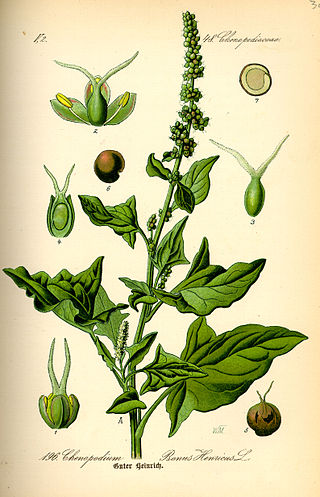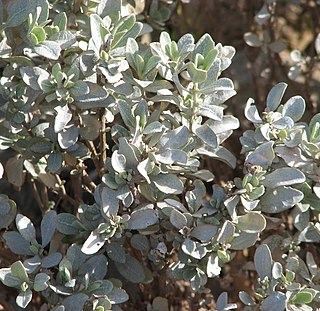
Clintonia is a genus of flowering plants in the lily family Liliaceae. Plants of the genus are distributed across the temperate regions of North America and eastern Asia, in the mesic understory of deciduous or coniferous forests. The genus, first described by Constantine Samuel Rafinesque in 1818, was named for DeWitt Clinton (1769–1828), a naturalist and politician from the U.S. state of New York. For this reason, plants of the genus are commonly known as Clinton's lily. The common name bluebead refer to the distinctive fruit of members of the genus. Since fruit color varies somewhat across species, the common name bead lily is used as well.

Blitum bonus-henricus, also called Good-King-Henry, poor-man's asparagus, perennial goosefoot, Lincolnshire spinach, Markery, English mercury, or mercury goosefoot, is a species of goosefoot which is native to much of central and southern Europe.

The Chenopodioideae are a subfamily of the flowering plant family Amaranthaceae in the APG III system, which is largely based on molecular phylogeny, but were included – together with other subfamilies – in the family Chenopodiaceae, or goosefoot family, in the Cronquist system.

Atriplex is a plant genus of about 250 species, known by the common names of saltbush and orache. It belongs to the subfamily Chenopodioideae of the family Amaranthaceae s.l.. The genus is quite variable and widely distributed. It includes many desert and seashore plants and halophytes, as well as plants of moist environments. The generic name originated in Latin and was applied by Pliny the Elder to the edible oraches. The name saltbush derives from the fact that the plants retain salt in their leaves; they are able to grow in areas affected by soil salination.

Atriplex vesicaria, commonly known as bladder saltbush, is a species of flowering plant of the family Amaranthaceae and is endemic to arid and semi-arid inland regions of Australia. It is an upright or sprawling shrub with scaly leaves and separate male and female plants, the fruit often with a bladder-like appendage.

Suaeda nigra, often still known by the former name Suaeda moquinii, is a species of flowering plant in the amaranth family, known by the vernacular names bush seepweed or Mojave sea-blite.
Chenopodium incognitum is a species of annual flowering plant in the family Amaranthaceae. It is difficult to tell apart from Chenopodium hians and Chenopodium atrovirens is often synonymized with one of those species by botanical authorities.

Stutzia is a plant genus in the subfamily Chenopodioideae of the family Amaranthaceae. It was described in 2010, replacing the illegitimate name Endolepis. It comprises two species, that have also been included in the genus Atriplex.

Urtica gracilis, commonly known as the slender nettle, tall nettle, or American stinging nettle, is a perennial plant plant without woody stems that is well known for the unpleasant stinging hairs on its leaves and stems. It is native to much of the North America from Guatemala northwards and temperate areas of South America. It is easily confused with the visually very similar Eurasian species Urtica dioica and is still listed in some resources as a subspecies of this plant. However, genetic analysis and experiments show that they are genetically distinct.

Atriplex fissivalvis, commonly known as gibber saltbush, is a plant species in the family Amaranthaceae, subfamily, Chenopodioideae. It occurs in the Australian states of South Australia, New South Wales, Queensland and the Northern Territory.

Chenopodium spinescens is a species of plant in the family Amaranthaceae and is endemic to all mainland states and territories of Australia where it is known as Rhagodia spinescens.

Atriplex holocarpa is a low-growing species of Atriplex (saltbush) found throughout arid regions of Australia. A. holocarpa is commonly known as pop saltbush, because its carpals pop when stepped upon.

Atriplex stipitata, commonly known as mallee saltbush, bitter saltbush and kidney saltbush, is a species of shrub in the family Amaranthaceae, found in all mainland states of Australia.

Atriplex prostrata, called the spear-leaved orache, hastate orache, thin-leaf orache, triangle orache, and fat hen, is a widespread species of flowering plant in the saltbush genus Atriplex, native to Europe, Macaronesia, northern Africa, Ethiopia, the Middle East, western Siberia, and Central Asia, and introduced to temperate North America, South America, Australia, New Zealand, Korea, Japan, and Primorsky Krai in far eastern Russia. It is a facultative halophyte.

Atriplex spongiosa, the pop saltbush, is a species of flowering plant in the family Amaranthaceae, native to central Australia, and introduced to South Africa and Iran. A halophyte, it can grow in media having an NaCl concentration over 600 mM.

Atriplex sturtii, commonly known as saltbush, is an endangered species within the widespread genus Atriplex.A. sturtii is a native Australian shrub and grows in the Channel Country bioregion, also referred to as 'Corner Country'.

Atriplex angulata, commonly known as fan saltbush or angular saltbush, is a species of flowering plant in the family Amaranthaceae. It is an annual to short-lived perennial subshrub, native to Australia, distributed throughout drier parts of the mainland.
Atriplex codonocarpa, the flat-topped saltbush, is a species of flowering plant in the family Amaranthaceae, native to Western Australia. It is often found growing on the outer edges of salt lakes.
Atriplex leptocarpa, the slender-fruit saltbush, is a species of flowering plant in the family Amaranthaceae, native to Australia, and introduced to Eritrea. It is typically found growing near rivers, lakes, and other periodically flooded areas.
Atriplex rhagodioides, the river saltbush, is a species of flowering plant in the family Amaranthaceae, found from southeastern South Australia to northwestern Victoria. It usually grows on river banks or on flats.













